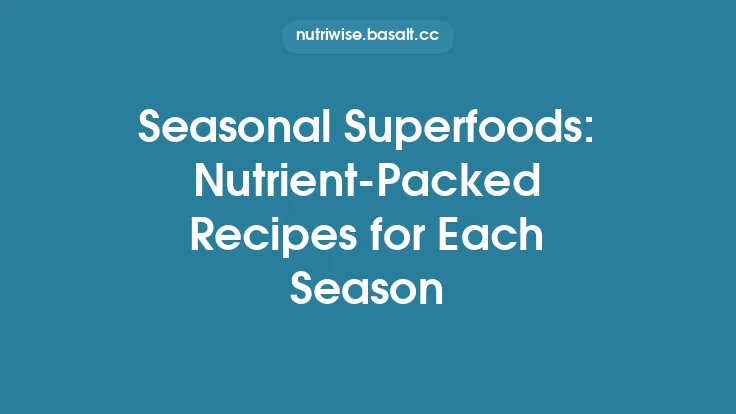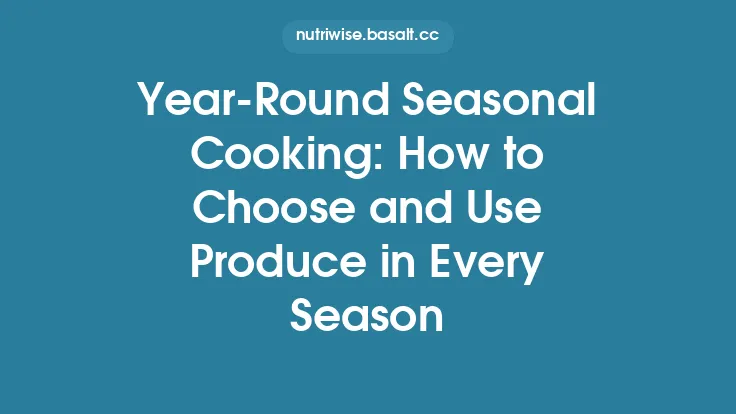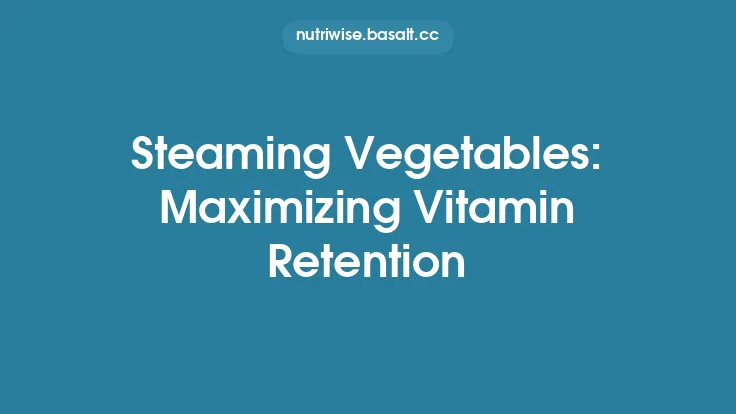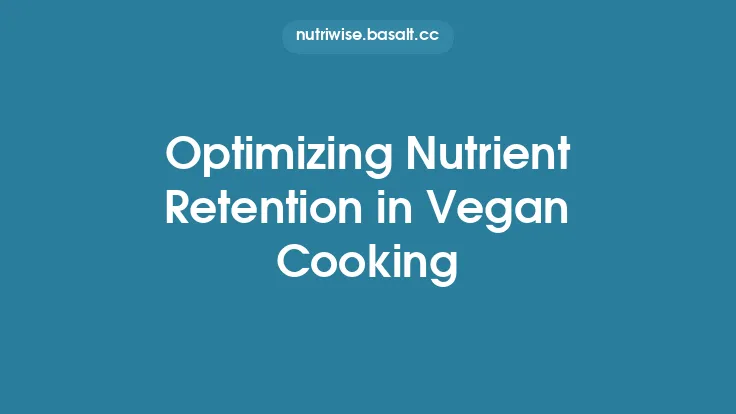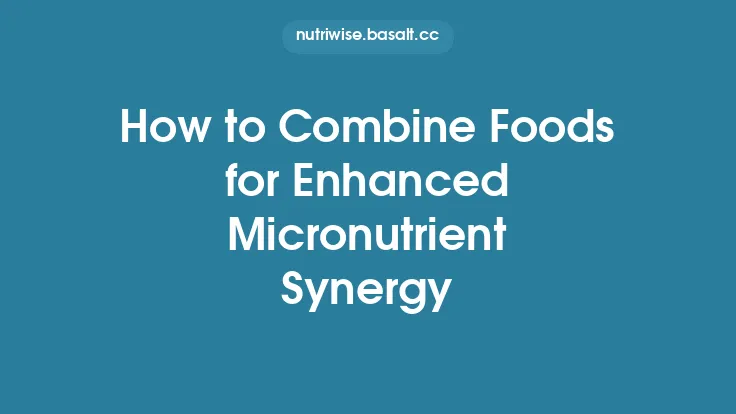Steaming and boiling are two of the most accessible, low‑fat cooking methods, yet they are often treated as interchangeable. In reality, each technique interacts with food’s cellular structure, water‑soluble nutrients, and flavor compounds in distinct ways. Understanding these differences allows you to select the method that best preserves the nutritional profile of vegetables, grains, legumes, and even proteins, while still delivering the texture and taste you desire.
Both steaming and boiling rely on water as the heat‑transfer medium, but the key distinction lies in the point of contact between the food and the liquid. In boiling, the food is fully immersed in water that is at or near 100 °C (212 °F) at sea level. In steaming, the food sits above the water, separated by a perforated barrier (such as a steamer basket), and is cooked by the rising steam that also reaches 100 °C. This seemingly subtle difference has profound implications for nutrient retention, flavor development, and the overall healthfulness of the final dish.
The Science of Nutrient Leaching
Water‑Soluble Vitamins
Vitamins B (especially B1, B2, B3, B6, and folate) and vitamin C are highly soluble in water. When foods are boiled, these vitamins can diffuse out of the cellular matrix and dissolve into the cooking water. The extent of leaching depends on several variables:
| Variable | Effect on Leaching |
|---|---|
| Temperature | Higher temperatures increase diffusion rates. |
| Cooking Time | Longer exposure allows more vitamins to migrate. |
| Surface Area | Smaller pieces (e.g., diced carrots) lose nutrients faster. |
| pH of Water | Slightly alkaline water can enhance vitamin C loss. |
Steaming dramatically reduces leaching because the food never contacts the water directly. The steam’s moisture condenses on the surface of the food, creating a thin film of water that is quickly re‑absorbed, limiting the gradient that drives vitamin diffusion. Studies consistently show that steaming retains 80‑95 % of vitamin C in broccoli, compared with 50‑70 % when boiled for the same duration.
Minerals and Phytochemicals
Minerals such as potassium, magnesium, and calcium are less prone to leaching than vitamins, but they can still be lost in the cooking water, especially when the water is discarded. Phytochemicals like glucosinolates (found in cruciferous vegetables) and polyphenols (in leafy greens) are also water‑soluble and can be partially extracted during boiling. Steaming preserves a higher proportion of these compounds, which are linked to antioxidant and anti‑inflammatory benefits.
Texture, Flavor, and Culinary Considerations
Texture Control
Boiling can lead to over‑softening, especially for delicate vegetables like spinach or asparagus. The constant immersion in water creates uniform heat distribution, which can break down pectin and cellulose more aggressively. Steaming, by contrast, provides a gentler heat exposure that allows the cell walls to retain more of their structural integrity, resulting in a firmer “al‑dente” bite.
Flavor Retention
Many vegetables develop a sweet, caramelized flavor when their natural sugars are concentrated through mild dehydration. Boiling dilutes these sugars in the cooking water, potentially muting the inherent sweetness. Steaming preserves the concentration of sugars and volatile aroma compounds, leading to a brighter, more vibrant flavor profile. For grains and legumes, steaming after an initial boil (the “par‑boil‑then‑steam” method) can achieve a fluffy texture while still locking in flavor.
Color Preservation
The bright green of peas, beans, and leafy greens is a visual cue of nutrient density. Boiling often results in a dull, olive‑toned hue due to the leaching of chlorophyll and the formation of iron‑chlorophyll complexes at high pH. Steaming maintains a vivid green because the brief exposure to water prevents chlorophyll degradation and the pH of the cooking environment remains more neutral.
Practical Guidelines for Choosing Between Steaming and Boiling
1. Prioritize Nutrient Retention
- Steaming is the default choice for vegetables rich in vitamin C, B‑vitamins, and water‑soluble phytochemicals (e.g., broccoli, bell peppers, kale, snow peas).
- Boiling can be acceptable for starchy vegetables (potatoes, sweet potatoes) where the primary goal is to soften the tissue for mashing or pureeing; the loss of water‑soluble nutrients is less critical because the carbohydrate content dominates the nutritional value.
2. Consider Cooking Time and Energy Efficiency
- Boiling reaches the target temperature faster because the entire pot of water is heated, making it more efficient for large volumes (e.g., cooking a full pot of pasta).
- Steaming may require a longer pre‑heat period, especially with a traditional stovetop steamer, but modern electric steamers and pressure‑steam devices can reduce this gap significantly.
3. Evaluate Desired Texture
- Steaming yields a firmer, more distinct texture, ideal for salads, side dishes, or when the vegetable will be further cooked (e.g., stir‑frying after steaming).
- Boiling produces a softer texture, suitable for soups, purees, or dishes where the vegetable will be mashed.
4. Factor in Post‑Cooking Use of Cooking Liquid
- If the cooking water will be repurposed (e.g., as a base for soups, sauces, or gravies), boiling becomes advantageous because the leached nutrients and flavors are retained in the liquid.
- When the cooking liquid is discarded, steaming is the superior method for preserving nutrients within the food itself.
5. Equipment Availability and Kitchen Workflow
- Steamer baskets, inserts, or dedicated steamers are inexpensive and stackable, making them ideal for small kitchens.
- Large pots are ubiquitous, and many cooks are already comfortable with boiling techniques, which can be a practical consideration for high‑volume cooking.
Optimizing Each Method for Maximum Nutrient Retention
Steaming Best Practices
- Use Minimal Water – Fill the pot just enough to generate steam without touching the food. Excess water can increase the time needed to reach boiling, prolonging exposure to heat.
- Cover Tightly – A snug lid traps steam, maintaining a consistent temperature and reducing cooking time.
- Cut Uniform Pieces – Consistency ensures even cooking and prevents over‑cooking of smaller pieces.
- Avoid Over‑Steaming – Most vegetables reach optimal tenderness within 3‑7 minutes. Use a timer and test with a fork.
- Season After Steaming – Adding salt, herbs, or a splash of citrus after cooking preserves the natural flavors and prevents the loss of water‑soluble compounds that can occur when seasoning is added to the water.
Boiling Best Practices
- Start with Cold Water – Placing vegetables in cold water and bringing them to a boil together helps maintain cell integrity and reduces nutrient loss compared with adding them to already boiling water.
- Use a Small Amount of Water – Just enough to cover the food minimizes the volume of nutrient‑rich water that must be discarded.
- Add Acidic Ingredients Sparingly – A pinch of lemon juice or vinegar can help preserve color in green vegetables but should be used judiciously to avoid altering pH dramatically, which can increase vitamin C degradation.
- Shock in Ice Water – Immediately transferring boiled vegetables to an ice bath (blanching) halts cooking, locks in color, and reduces further nutrient loss. The cooling water can be saved for soups if desired.
- Reuse the Cooking Water – For dishes like risotto, grain pilafs, or soups, the nutrient‑laden water can be incorporated, effectively recapturing the vitamins and minerals that leached out.
Special Cases: Grains, Legumes, and Proteins
Grains (Rice, Quinoa, Bulgur)
- Boiling is the conventional method, but a steam‑after‑boil step (cover and let sit off heat) improves texture and reduces the need for excess water, thereby limiting nutrient loss.
- For whole‑grain varieties, pre‑soaking followed by steaming can preserve B‑vitamins better than a prolonged boil.
Legumes (Beans, Lentils, Chickpeas)
- Boiling is necessary to soften the tough seed coat and deactivate anti‑nutrients like lectins. However, a short boil followed by steaming (or using a pressure steamer) can reduce cooking time while retaining more folate and iron.
- Discarding the soaking water is advisable, as it contains oligosaccharides that can cause digestive discomfort, but the final cooking water should be retained for nutrient recovery.
Proteins (Fish, Chicken, Tofu)
- Steaming is ideal for delicate proteins such as fish fillets and tofu, preserving moisture and preventing the loss of water‑soluble nutrients (e.g., B‑vitamins) that can leach into boiling water.
- Boiling is appropriate for tougher cuts of meat when the goal is to create a broth; the nutrients released into the liquid become part of the final dish, turning a potential loss into a gain.
Environmental and Health Perspectives
From a health standpoint, both steaming and boiling are low‑fat, low‑calorie cooking methods that avoid the need for added oils or fats. However, the energy footprint can differ:
- Steaming often requires less water, reducing the energy needed to heat large volumes of liquid. Modern electric steamers are highly efficient, using only the heat necessary to generate steam.
- Boiling can be more energy‑intensive, especially when large pots of water are used for relatively small amounts of food. Choosing a pot size that matches the quantity of food and using a lid can mitigate this.
Both methods align with dietary guidelines that encourage cooking techniques preserving micronutrients while minimizing added fats. By selecting the appropriate method based on the food type, desired texture, and intended use of cooking liquids, you can maximize nutrient retention and support overall health.
Quick Reference Cheat Sheet
| Food Type | Recommended Method | Reasoning |
|---|---|---|
| Leafy greens (kale, spinach) | Steaming (2‑4 min) | Preserves vitamin C, chlorophyll, and bright color |
| Cruciferous veg (broccoli, cauliflower) | Steaming (5‑7 min) | Retains glucosinolates and B‑vitamins |
| Starchy veg (potatoes, carrots) | Boiling (10‑15 min) then steam (2‑3 min) | Softens interior, retains flavor, optional nutrient recovery in water |
| Whole grains (brown rice, quinoa) | Boil (1:2 ratio) → Steam (10 min) | Ensures full hydration, improves texture, limits B‑vitamin loss |
| Legumes (beans, lentils) | Boil (until tender) → Steam (5 min) | Deactivates anti‑nutrients, preserves folate |
| Fish fillets, tofu | Steaming (5‑10 min) | Keeps moisture, protects water‑soluble nutrients |
| Soup bases, stocks | Boiling (long simmer) | Nutrients leached into liquid become part of the dish |
Final Thoughts
Choosing between steaming and boiling is not a binary decision but a nuanced choice that hinges on the specific food, the nutrients you wish to protect, and how you plan to use the final product. By understanding the mechanisms of nutrient leaching, texture development, and flavor preservation, you can tailor your cooking approach to achieve maximum health benefits while delivering delicious, satisfying meals. Embrace steaming for its superior nutrient retention and vibrant results, reserve boiling for situations where the cooking liquid itself becomes a valuable component, and always consider the downstream use of that liquid to ensure nothing nutritious goes to waste.

